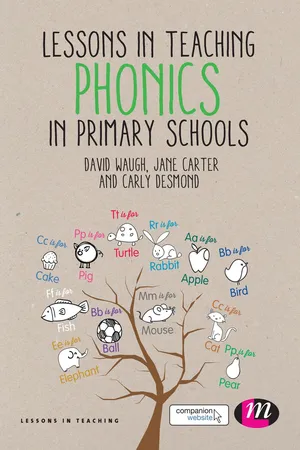
- 176 pages
- English
- ePUB (mobile friendly)
- Available on iOS & Android
Lessons in Teaching Phonics in Primary Schools
About This Book
Lesson planning in line with the new Primary National Curriculum! Phonics is taught every day in primary schools across England. It is fully embedded in the National Curriculum and is a huge part of teaching children to read. How do you ensure that you understand both what and how to teach? How do you separate good phonics teaching from the many phonics schemes that are used? What does a good phonics lesson look like? This text provides exemplar lessons in phonics and supports you to teach tricky words, alternative spellings, and pronunciation as well as addressing other phonics teaching challenges. It explores the most popular phonics schemes and shows you how good phonics teaching works across schemes. The adaptable and inspired lesson plans included, highlight how phonics teaching can be fun, offering ideas for teaching phonics outdoors, whole class phonics teaching and nonsense words. Did you know that this book is part of the Lessons in Teaching series? WHAT IS THE LESSONS IN TEACHING SERIES?
Suitable for any teacher at any stage of their career, the books in this series are packed with great ideas for teaching engaging, outstanding lessons in your primary classroom. The Companion Website accompanying the series includes extra resources including tips, lesson starters, videos and Pinterest boards. Books in this series: Lessons in Teaching Grammar in Primary Schools, Lessons in Teaching Computing in Primary Schools, Lessons in Teaching Number and Place Value in Primary Schools, Lessons in Teaching Reading Comprehension in Primary Schools, Lesson in Teaching Phonics in Primary Schools
Frequently asked questions
Information
Chapter 1 Why phonics?
Learning Outcomes
- gain an historical perspective of the role of phonics in the teaching of early reading;
- develop an understanding of some of the theoretical underpinnings for the teaching of early reading and phonics;
- gain an overview of some of the research evidence.
Teachers’ Standards
- 3. Demonstrate good subject and curriculum knowledge:
- Have a secure knowledge of the relevant subject(s) and curriculum areas, foster and maintain pupils’ interest in the subject, and address misunderstandings.
- Demonstrate a critical understanding of developments in the subject and curriculum areas, and promote the value of scholarship.
- Demonstrate an understanding of and take responsibility for promoting high standards of literacy, articulacy and the correct use of standard English, whatever the teacher's specialist subject.
- If teaching early reading, demonstrate a clear understanding of systematic synthetic phonics.
Introduction
Why the Focus on the Teaching of Reading?
I was once in New York, and I listened to a talk about the building of private prisons – a huge growth industry in America. The prison industry needs to plan its future growth – how many cells are they going to need? How many prisoners are there going to be, 15 years from now? And they found they could predict it very easily, using a pretty simple algorithm, based about asking what percentage of ten and eleven year olds couldn't read. And certainly couldn't read for pleasure.
What is Reading?
Reading in the Curriculum
All pupils must be encouraged to read widely across both fiction and non-fiction to develop their knowledge of themselves and the world in which they live, to establish an appreciation and love of reading, and to gain knowledge across the curriculum. Reading widely and often increases pupils’ vocabulary because they encounter words they would rarely hear or use in everyday speech. Reading also feeds pupils’ imagination and opens up a treasure-house of wonder and joy for curious young minds.It is essential that, by the end of their primary education, all pupils are able to read fluently, and with confidence, in any subject in their forthcoming secondary education.(DfE, 2013, p4)
Skilled word reading involves both the speedy working out of the pronunciation of unfamiliar printed words (decoding) and the speedy recognition of familiar printed words. Underpinning both is the understanding that the letters on the page represent the sounds in spoken words. This is why phonics should be emphasised in the early teaching of reading to beginners (i.e. unskilled readers) when they start school.
Activity: Elements of Reading
- Link what children read or hear read, to their own experiences.
- Read accurately by blending the sounds in words.
- Check that the text makes sense as you read and correct inaccurate reading.
- Predict what might happen on the basis of what has been read so far.
- Read words containing common suffixes.
- Read accurately recognising alternative sounds for graphemes.
What is Phonics?
Table of contents
- Cover
- Half Title
- Publisher Note
- Title Page
- Copyright Page
- Contents
- The Authors
- Acknowledgements
- Introduction
- Chapter 1 Why phonics?
- Chapter 2 Phonics in Context
- Chapter 3 Reception: Developing Phonemic Awareness
- Chapter 4 Reception: Beginning to Read and Write using CVC Words
- Chapter 5 Year 1: Teaching Grapheme–Phoneme Correspondences
- Chapter 6 Year 1: Long Vowel Digraphs
- Chapter 7 Year 1: Decoding and Encoding Text
- Chapter 8 Years 1 and 2: Morphemes – Prefixes, Suffixes and Root Words
- Chapter 9 Year 2: Homophones and Contractions
- Chapter 10 Year 2: Phonics into Spelling
- Chapter 11 Teaching Tricky or Common Exception Words
- Chapter 12 Moving On
- Glossary
- Index